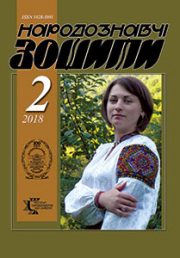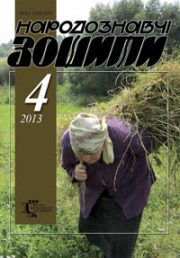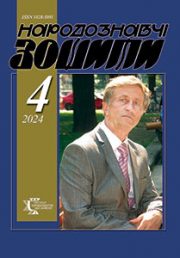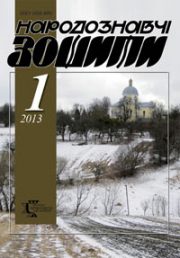The Ethnology Notebooks. 2021. № 5 (161), 1042—1049
UDK [930.85:929.7:316.6](477)”653/654″
DOI https://doi.org/10.15407/nz2021.05.1042
VASIANOVYCH Oleksandr
- ORCID ID: https://orcid.org/0000-0001-9360-6447
- Сandidate of History (Ph. D),
- Deputy Director for Research,
- State Scientific Center for Protection
- of Cultural Heritage
- from Technological Disasters,
- 56, ave. Peremogy, 03057, Kyiv, Ukraine,
- Contacts: e-mail: guru_v@ukr.net
BALUSHOK Vasyl
- ORCID ID: https://orcid.org/0000-0003-1362-8270
- PhD in History, Senior Research Fellow,
- Maksym Rylskyi Institute of Art Studies,
- Folklore Studies and Ethnology,
- National Academy of Sciences of Ukraine,
- 4, Hrushevskoho str., 01001, Kyiv, Ukraine,
- Contacts: e-mail: grigras@i.ua
Abstract. Introduction: The Ukrainian gentry, as a special social group, had separate, inherent in it, elements of traditional culture. Problem Statement: For a long time, the Ukrainian society was dominated by the opinion about the absence of its own national elite, which was supposed to lead the common people. Therefore, it is worth finding aristocratic features in the life of the small gentry, which was weakly amenable to assimilation, being among the ordinary peasantry, becoming a trendsetter and innovator. Purpose: To consider the features of the material and spiritual culture of the Ukrainian small gentry that served as the basis for its separation among ordinary people and the preservation of social identity. Methods: Relying on archival, published data, realistic descriptions in fiction, to highlight the features of a gentry culture that were markers of social identity in the rural environment.
Results: In the construction of housing, it differed almost nothing from ordinary peasants, although in detail it often differed from the latter. Gentries from different regions of Ukraine installed urban furniture in the house: beds, chests of drawers, cabinets, etc. Gentry attire mainly corresponded to the clothes of the rural population of the 19th early 20th centuries, but it had certain bourgeois elements. In general, the gentry, who was the arbiter of fashion, influenced the clothes of ordinary peasants, who adopted certain items of clothing from the former. Gentries and peasants grouped separately in the church, school, inn, they mocked at each other. The petty gentry had some, albeit minor, differences from the peasants in spiritual culture. Considering themselves a segment slightly higher than the peasants, the gentry, with few exceptions, tried to maintain their caste isolation by marrying only among themselves.
Conclusion: The Ukrainian petty gentry in the 19th — early 20th centuries deliberately supported more-or-less significant differences in household culture, thus trying to emphasize their nobility and rise above «the churl» and «the bumpkin».
Keywords: gentry, Ukraine, material culture, spiritual culture, social identity.
Received 28.07.2021
REFERENCES
- Holovatsky, Ya. (1869). About costumes or folk decoration of Rusyns or Russians in Galicia and Northeastern Hungary. Sankt-Peterburh [in Russian].
- Franko, I. (1980). Needs to study the language and ethnography of the Ukrainian people. Something about the gentry walking (Vol. 26, pp. 180—186). Kyiv [in Ukrainian].
- Cherv’iak, K. (1928). The surrounding nobility in the Korosten region, 3, 13—44 [in Ukrainian].
- Cherv’iak, K. (1929). Carpet weaving in the Korosten region. Local lore. Kyiv [in Ukrainian].
- Ponomar, L. (2002). Until recently on the land of the Drevlians. Ukrainian culture, 3, 28—29 [in Ukrainian].
- Vasianovych, O. (2004). A friend carries a loaf, shakes a hint (Women’s clothing of the gentry of the surrounding village of Meleni). Bereginya, 1, 67—76 [in Ukrainian].
- Vasianovych, O. (2008). Traditional and household culture of the Galician petty gentry of the XIX — early XX centuries (in the works of Andrei Tchaikovsky). Folk art and ethnography, 5, 99—105[in Ukrainian].
- Vasianovych, O. (2011). Significant functions of carpets of the surrounding gentry of Zhytomyr region. Folk art and ethnography, 6, 53—57 [in Ukrainian].
- Vasianovych, O. (2017). Features of nutrition of the small Ukrainian nobility in the XIX — early XX centuries. Bulletin of VN Karazin Kharkiv National University. Series «History of Ukraine. Ukrainian Studies: Historical and Philosophical Sciences» (Issue 24, pp. 68—74).Kharkiv [in Ukrainian].
- Nesen, I. (2004). Surrounding gentry of Central Polissya: features of the wedding ritual. Folk art and ethnography, 6, 91—97 [in Ukrainian].
- Nesen, I. (2008). Surrounding gentry in the north-eastern Zhytomyr region: features of historical development and ethnographic life. Scientific notes on Ukrainian history (Issue 21, pp. 84—97) [in Ukrainian].
- Nesen, I. (2009). Funeral and funeral rites in the environment of the «surrounding» nobility of the North-Eastern Zhytomyr region (late XIX — early XX century). Bulletin of Lviv University. The series is historical (Issue 44, pp. 241—264). L’viv [in Ukrainian].
- Balushok, V. (2006). «Unnoticed»social strata (the fate of the Ukrainian nobility after Khmelnytsky in the works of modern researchers). Ukrainian Humanitarian Review (Issue 12, pp. 180—189). Kyiv [in Ukrainian].
- Balushok, V. (2007). Ukrainian nobility between Polish and Ukrainian ethnic groups. Folk art and ethnography, 6, 11—25 [in Ukrainian].
- Balushok, V. (2016). From the history of the nobility of Fastiv region. «Press Museum». Scientific information bulletin, 2 (43), 3—54 [in Ukrainian].
- Slyvka, L. (2009). Galician petty gentry in Austria-Hungary (1772—1914). Ivano-Frankivs’k [in Ukrainian].
- Bekh, M.V. (2018). Traditions and transformations in ethnoculture and life of Bekha village in Zhytomyr region of the end of the XIX — first half of the XX century. Kyiv [in Ukrainian].
- Dobkowskij, P. (1936). Wall nobility in Korczyn and Kruszelnica on Stryj. L’viv [in Polish].
- Vytvyts’ka, O. (Ed.). (1992). History of Vytvytsia in documents and memoirs. Without a city [in Ukrainian].
- Slyvka, L. (2004). Culture and built the smallest road in Galicia (late ХVІІІ — early ХХ century). Galicia, 10, 235—241 [in Ukrainian].
- Chajkovs’kyj, A. (1966). Oliun’ka (Pp. 77—240). L’viv [in Ukrainian].
- Chajkovs’kyj, A. (1920). Minor. Kyiv; Stanyslaviv [in Ukrainian].
- Tsehlyns’kyj, H. (1911). The nobility is a walker. L’viv [in Ukrainian].
- Zelenin, D. (1914). Description of the manuscripts of the scientific archive of the Imperial Russian Geographical Society (Issue 1). Petrohrad [in Russian].
- Chajkovs’kyj, A. (1994). In someone else’s nest. Stories from the XIX century (Vol. 5, pp. 26—348). L’viv [in Ukrainian].
- Svyryda, R.O. (1979). Equipment of traditional housing of the Right Bank Polissya. Folk art and ethnography, 3, 56—63 [in Ukrainian].
- Nechuj-Levyts’kyj, I. (1966). Buried aliveю (Vol. 7, pp. 260—293). Kyiv [in Ukrainian].
- Hurkov, V.S., & Hoshko, R.U. (1988). Settlements. Polesie. Material culture (Pp. 279—333). Kyіv [in Russian].
- Yurkevych, L. (2012). Pokodym gentry. Materials of ethnographic description. 20s of the XX century. Department of Manuscripts of the VI Vernadsky National Library of Ukraine. Folk art and ethnography, 4, 139—146 [in Ukrainian].
- Stel’maschuk, H. (1980). Traditional clothes of Zhytomyr region. Folk art and ethnography, 6, 77—82 [in Ukrainian].
- (1988). Ukrainian folk clothing of the XVIII — early XIX centuries. in watercolors by Yu. Hlogovsky. Kyiv [in Ukrainian].
- Ponomar, L. (1989). The origin of the names of Ukrainian folk clothing in Polissya. Folk art and ethnography, 5, 33—41 [in Ukrainian].
- Kuzych-Berezovs’ky, I. (1962). Berezovsky nobility against the background of the history of Ukraine. Detrojt [in Ukrainian].
- Sorodnyk, S. (2002). History of the Korchyn nobility. Past and present of the village of Korchyn. L’viv [in Ukrainian].
- Archival scientific funds of manuscripts and phonographs of the Institute of Art History, Folklore and Ethnology M.T. Rylsky NAS of Ukraine (hereinafter — ANFRF IMFE). F. 15—1. Od. zb. 48.
- ANFRF IMFE. F. 15—1. Od. zb. 158.
- ANFRF IMFE. F. 15—1. Od. zb. 159.
- ANFRF IMFE. F. 15—1. Od. zb. 213.
- ANFRF IMFE. F. 1—4. Od. zb. 249.
- Zalizniak, L.L. (2017). Ovruch surrounding gentry and problems of the beginning of Ukrainogenesis. Magisterium. Archaeological studies (Issue 67, pp. 115—124) [in Ukrainian].







